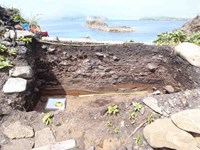- Lesson Plan (9)
- Distance Learning (2)
- Field Trips (1)
- Guest Speakers (1)
- Primary Sources (1)
- Student Activities (1)
- Acadia National Park (1)
- Andersonville National Historic Site (1)
- Assateague Island National Seashore (1)
- First Ladies National Historic Site (1)
- Friendship Hill National Historic Site (1)
- Hopewell Culture National Historical Park (1)
- New Orleans Jazz National Historical Park (1)
- Stones River National Battlefield (1)
- Tule Springs Fossil Beds National Monument (1)
- Show More ...
- Social Studies (10)
- Science (7)
- Literacy and Language Arts (2)
- Math (1)
- 11-12.RH.1 (2)
- 11-12.RH.2 (2)
- 9-10.RH.1 (2)
- 9-10.RH.2 (2)
- 11-12.RH.10 (1)
- 11-12.RH.3 (1)
- 11-12.RH.6 (1)
- 11-12.RH.7 (1)
- 11-12.RH.8 (1)
- Show More ...
Showing 13 results for radiocarbon dating ...
National Parks in the History of Science: Radiocarbon Dating Video Notetaker
Virtual: Grades 7-10: Waves in Acadia – Sound and Light
- Type: Distance Learning
- Grade Levels: Middle School: Sixth Grade through Eighth Grade
Draw sonograms. Measure infrared. Chart radio waves. Explore real world examples of light and sound waves in Acadia National Park with this interactive, virtual program. (1 hour)
First Ladies and Technology
- Type: Distance Learning ... Field Trips ... Guest Speakers
- Grade Levels: Middle School: Sixth Grade through Eighth Grade

How would your life be different without technology? For First Ladies, their job would be a lot harder! In this program, we’ll learn how First Ladies Jackie Kennedy, Michelle Obama, and Eleanor Roosevelt used radio, television, and Social Media in their role and explore the science behind their technologies.
- Type: Lesson Plan
- Grade Levels: High School: Ninth Grade through Twelfth Grade

The New Deal reform, recovery, and relief programs changed the relationship between American’s and their government in revolutionary ways. The Resettlement Administration (RA), Federal Emergency Relief Administration (FERA), and the Farm Security Administration (FSA) were programs to get displaced families off relief. More than eighty years after the Matanuska Colony was established much of it remains to tell the story of the New Deal resettlement program in Alaska.
Lesson 2 - MAROONED FOR FREEDOM
- Type: Lesson Plan
- Grade Levels: High School: Ninth Grade through Twelfth Grade
This lesson uses a song from the New Orleans Jazz National Historical Park cd Remembering 300: The Arrowhead Jazz Band, and a podcast from New Orleans Public Radio: More Than A Runaway: Maroons In Louisiana, https://www.wwno.org/post/more-runaway-maroons-louisiana . It concerns the history of free settlements established by escaped slaves in isolated areas of Louisiana, and the most famous leader of those settlements, San Malo, also called St. Malo or Juan Malo
- Type: Lesson Plan
- Grade Levels: Upper Elementary: Third Grade through Fifth Grade
Libby life: experiences of a prisoner of war in Richmond, Va., 1863-64
- Type: Primary Sources
- Grade Levels: Upper Elementary: Third Grade through Fifth Grade
Learning from Spanish Coins
- Type: Lesson Plan
- Grade Levels: Upper Elementary: Third Grade through Fifth Grade

In this lesson, students learn about 18th-century Spanish currency. Teachers can use the lesson plan to help their students investigate how archeologists use artifacts like coins to come up with a relative date for an archeological site. Students will understand how archeologists use newer technologies, such as 3D modeling and Virtual Reality, in order to analyze and interpret artifacts and objects.
PB & J Archeology
The Trail of Tears in Middle Tennessee
- Type: Lesson Plan
- Grade Levels: High School: Ninth Grade through Twelfth Grade
Albert Gallatin: A Most Astonishing Man - Gallatin's Family Life and Timeline - Lesson 7
- Type: Lesson Plan
- Grade Levels: Middle School: Sixth Grade through Eighth Grade

Gallatin was a happy family man and enjoyed being with his wife and children. The family got to experience many locations as Gallatin moved from one political assignment to another. Students will read about Gallatin’s family life and where the family lived in the student reading. Then using the dates in the reading, the students will make a Gallatin family life timeline.
- Type: Lesson Plan
- Grade Levels: Upper Elementary: Third Grade through Fifth Grade

In this lesson students will learn about tree rings and how archaeologists use them to help date sites and artifacts. What are tree rings? How are tree rings used to determine the age of archaeological sites? Students will... ●Understand how trees grow and why growth rings are formed. ●Describe how climate and weather affects the growth of tree rings. ●Explain the age of a tree by its rings. ●Understand how ring patterns can be used to determine the age of archaeological sites.






